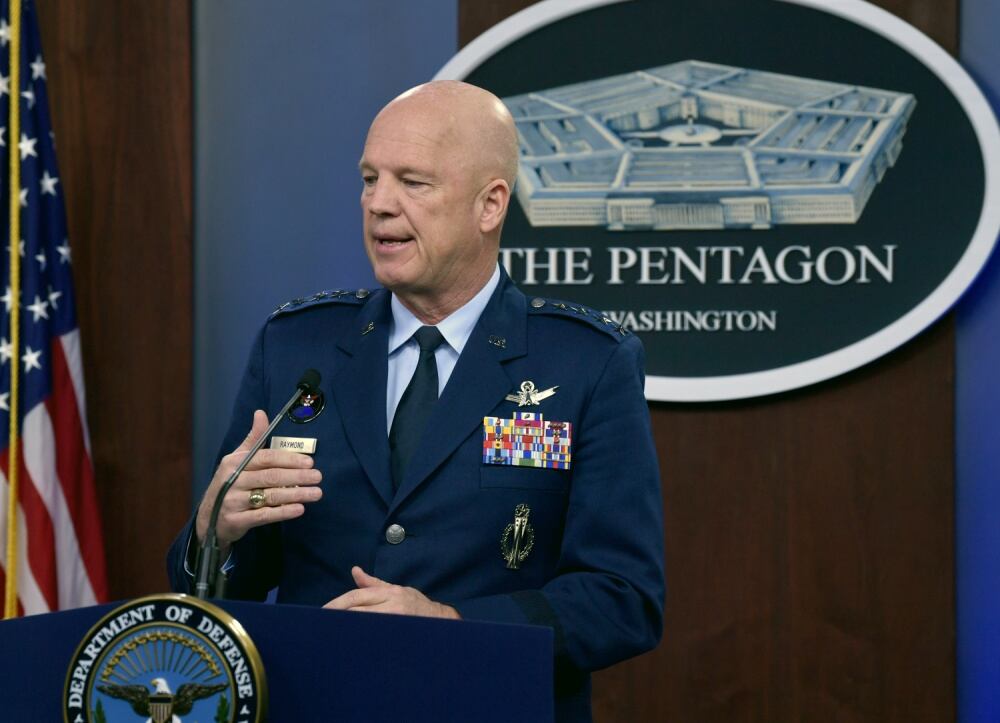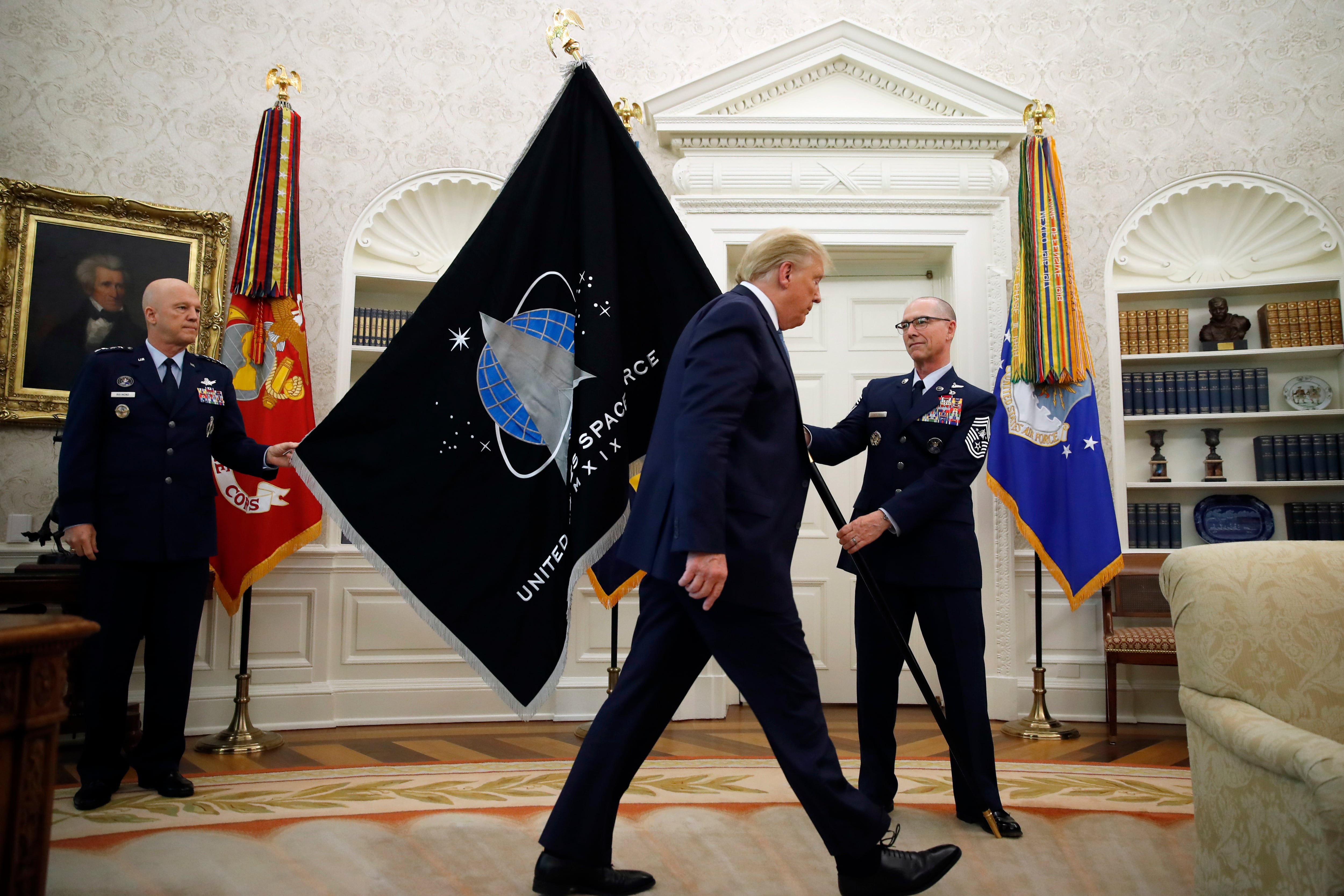WASHINGTON — Just days before the first anniversary of the U.S. Space Force, the White House has issued a new national space policy. In addition to outlining priorities for civilian and commercial space growth, the Dec. 9 document outlines how the outgoing administration wants the military and the intelligence community to approach space.
“The new National Space Policy is my plan for how the executive branch will advance United States interests in space for the benefit of the American people,” President Donald Trump said in a statement. “By charting a clear course for United States space activities, this policy reaffirms our leadership in the space domain and our status as the world’s foremost spacefaring nation.”
RELATED

As with past Trump administration declarations, national security officials blame nations like China and Russia for making space a war fighting domain, justifying efforts to increase the resilience of America’s space-based capabilities and ensure the military’s ability to conduct offensive and defensive operations in and through space.
“The United States is committed to the safety, stability, security and long-term sustainability of space activities, and the Department of Defense is a key partner in ensuring we continue to have the freedom to operate in, from and through the critical space domain,” said acting Secretary of Defense Christopher C. Miller. “Our adversaries have made space a war fighting domain and we have to adapt our national security organizations, policies, strategies, doctrine, security classification frameworks and capabilities for this new strategic environment. Over the last year we have established the necessary organizations to ensure we can deter hostilities, demonstrate responsible behaviors, defeat aggression and protect the interests of the United States and our allies.”
Director of National Intelligence John Ratcliffe was more specific in describing the perceived threat during comments to the National Space Council, an executive-office advisory body the Trump administration revived in 2017
“America’s vital interests are increasingly at risk as China and Russia develop and field destructive weapons to threaten U.S. and allied space capabilities,” said Ratcliffe. “Russia in particular has recently demonstrated provocative behavior creating a potentially dangerous situation in space.”
Chief of Space Operations Gen. John “Jay” Raymond has been vocal in calling out perceived Russian aggression in space, particularly a series of Russian space vehicles that have demonstrated the capability of ejecting a high-speed projectile on orbit. Raymond has stated previously that these space vehicles are weapons, something Vice President Mike Pence repeated Dec. 9.
“China and Russia are continuing to develop space weaponry,” said Vice President Mike Pence in remarks to the National Space Council. “Russia demonstrated a space-based anti-satellite weapon earlier this year. China is developing a new manned space station, and its robotic spacecraft will return samples from the moon in just a matter of weeks.”
The new policy emphasizes three main thrusts for national security in space: increasing space situational awareness, establishing norms of behavior in space, and growing the resilience of the nation’s on-orbit capabilities. It also further cements the Space Force’s role in defending American interests in space.
SPACE SITUATIONAL AWARENESS
Specifically, the policy calls on DoD to ensure the military knows what is happening in space.
With regards to the intelligence community, the policy designates space as a “priority intelligence domain.” Ratcliffe noted that his office had already begun directing a significant, classified investment to counter space threats and support the intelligence requirements of the still nascent Space Force. He is also working with the service to establish a new National Space Intelligence Center.
The office is evaluating whether to designate the Space Force as the 18th member of the intelligence community, said Ratcliffe. Each of the other services has an intelligence community component.
“We anticipate a decision on this history-making opportunity in the next few months, which would profoundly strengthen the partnership between the Department of Defense and the intelligence community,” said Ratcliffe.
NORMS OF BEHAVIOR
The policy directs the secretary of defense to promote standards for behavior of space, while also calling out undesirable or irresponsible activities by other nations. Since the U.S. Space Command was revived in 2019, it has been vocal in decrying what it perceives as aggressive actions in space — specifically the Russian activities mentioned earlier.
“The national space policy also directs the United States to continue to adapt its national security strategy to defeat aggression and protect national interests in space,” said the president. “As part of this effort, the newly created sixth branch of our Armed Forces, the Space Force, will enhance the capabilities of our Armed Forces to protect our freedom of operation in, from and to space.”
Secretary of State Mike Pompeo added in a statement that his department would “encourage and uphold the right of nations to responsibly and peacefully use space, while identifying and resolving behaviors that threaten that right.”
If deterrence fails, the policy calls on the defense secretary “to defeat aggression while protecting and defending United States vital interests with allies and partners.”
RESILIENCE
While deterring aggression in space is the goal, the policy also prioritizes the need for the Space Force to make the nation’s space-based capabilities more resilient — either by making it more difficult for adversaries to deny or destroy those capabilities, or by making it easier for the U.S. to quickly replace space vehicles.
As part of that emphasis on resilience, the document brings up a common Pentagon space priority called responsive launch. Defense leaders want a rapid launch capability that could quickly put payloads on orbit with little notice or turnaround time. That way, if an adversary takes out a critical national security satellite — or it fails on its own — the government can quickly replace it.
In addition, if commanders determine they need a specific space-based capability for the battlefield, but there are no on-orbit assets available, the Space Force could launch a new payload into orbit to fulfill that mission in a timely manner.
The Pentagon has had limited success in developing a responsive launch capability. No company was able to complete a Defense Advanced Research Projects Agency competition designed to find a commercial rapid launch provider, although Astra Space came within inches — only to have multiple launch attempts scrubbed due to inclement weather. Recently, Aevum announced that it hopes to be the premier responsive launch provider with a slightly novel solution — launching rockets from the air via drone. According to the CEO, the company’s method isn’t impacted by inclement weather the way traditional launches are, and the drone has a turnaround time of just 180 minutes. Aevum has already locked down a handful of Space Force contracts and could launch its first mission in 2021.
The White House’s new policy charges the defense secretary with developing “rapid launch options to reinforce or to reconstitute priority national security space capabilities in times of crisis and conflict and that, when practicable and appropriate, leverage commercial capabilities.”
The timing of the document — just days before the Dec. 20 anniversary of the Space Force’s creation — should be noted.
“The national space policy guides the efforts of the United States Space Force as we continue to deliver capabilities and forces in defense of our nation’s interests in space,” said Raymond in a statement. “The strategic environment demands we act boldly, with speed and decisiveness, to ensure we provide advantage to the nation and our allies, and this policy paves the way.”
Nathan Strout covers space, unmanned and intelligence systems for C4ISRNET.








